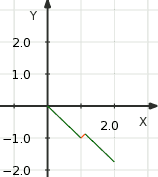Imagine a complex pattern in which you are moving steadily backwards through time. You are moving in "negative time" as opposed to normal, positive time. Every second that passes, you move backward one second.
But slowly, you start to experience regular, recurring "skips" in which time moves forward, like normal. These skips get longer and more frequent. At the same time, after each skip, you experience a jump backward (an actual "time travel" event in which you jump suddenly to a different point in time). These jumps backward are also brief at first, like the "skips." On the whole, this pattern keeps you moving backwards in time instead of forward.
You are able to use a stopwatch to measure your movements through time, accurate to a tenth of a second. You time your movements over three days, once per day at the same time every day, so you can come up with a pattern rule and a formula that will allow you to predict where and when you'll move next, or how your trajectory will change as you move backward.
You start at exactly 12 p.m. on Monday, March 3rd. You move steadily backwards through time all day of course, and you continue to experience these regular "skips," but at noon you record the following with your stopwatch: Your first recorded time shows that you moved steadily backwards for one minute, and then you moved in normal time forward for one second. That brings you to 11:59:01. After the short moment forward, you jumped backwards 1.3 seconds. At the end of the cycle, the time is 11:58:59.7 p.m. The cycle repeats, starting from that time, but you don't measure it again until the previous day.
At noon on Sunday, March 2nd, you record this: You move steadily backwards for 55 seconds, then move forward in time 1.2 seconds. Then you jump back 2 seconds.
At noon on Saturday, March 1st, you record this: You move steadily backwards for 50 seconds, ten move forward in time 1.4 seconds, then you jump back 3.1 seconds.
How would you express this movement as a formula that would allow you to predict how long your next jumps will last at any point in the past?
But slowly, you start to experience regular, recurring "skips" in which time moves forward, like normal. These skips get longer and more frequent. At the same time, after each skip, you experience a jump backward (an actual "time travel" event in which you jump suddenly to a different point in time). These jumps backward are also brief at first, like the "skips." On the whole, this pattern keeps you moving backwards in time instead of forward.
You are able to use a stopwatch to measure your movements through time, accurate to a tenth of a second. You time your movements over three days, once per day at the same time every day, so you can come up with a pattern rule and a formula that will allow you to predict where and when you'll move next, or how your trajectory will change as you move backward.
You start at exactly 12 p.m. on Monday, March 3rd. You move steadily backwards through time all day of course, and you continue to experience these regular "skips," but at noon you record the following with your stopwatch: Your first recorded time shows that you moved steadily backwards for one minute, and then you moved in normal time forward for one second. That brings you to 11:59:01. After the short moment forward, you jumped backwards 1.3 seconds. At the end of the cycle, the time is 11:58:59.7 p.m. The cycle repeats, starting from that time, but you don't measure it again until the previous day.
At noon on Sunday, March 2nd, you record this: You move steadily backwards for 55 seconds, then move forward in time 1.2 seconds. Then you jump back 2 seconds.
At noon on Saturday, March 1st, you record this: You move steadily backwards for 50 seconds, ten move forward in time 1.4 seconds, then you jump back 3.1 seconds.
How would you express this movement as a formula that would allow you to predict how long your next jumps will last at any point in the past?

